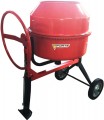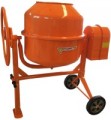Max. power
The power of the motor used to rotate the working mechanism of the cement mixer. This parameter can be called secondary, because. it is selected depending on the volume of the drum (see above) — in such a way as to ensure rotation without problems at the maximum working load (see "Volume of the finished mixture"). And the main criterion when choosing a cement mixer is still the volume of the drum. However, models of equal volume may vary in power, and to determine the optimal option, it is necessary to take into account the planned operating conditions.
So, the "ceiling" in terms of power for small cement mixers with a volume of up to 130 liters, designed for use in individual construction, is 700-800 W — this is quite enough for normal operation without excessive electricity costs. If you need continuous operation for 10 hours or more, you should pay attention to more powerful models. It is also recommended to have a power reserve if the cement mixer has to be used with unstable networks where voltage drops are possible.
Drum tilt lock
The device fixing the drum affects the principle and convenience of unloading the finished mixture from the cement mixer.
—
Manual. Manual swivel wheel in the design of a cement mixer. To unload the mixture, it is necessary to pull it towards you, after loosening, turn the drum to the required angle of inclination of the cement mixer, and release the wheel. The load in this case falls on the hands.
—
Foot. The rotary wheel for adjusting the angle of the drum in the design of the foot lock is supplemented with an L-shaped pin or pedal, the protruding part of which is pressed by the foot. The advantage of this solution is that in order to loosen the mechanism for fixing the drum, force must be applied to pressing the "poker", and there is a minimum load on the hands.

